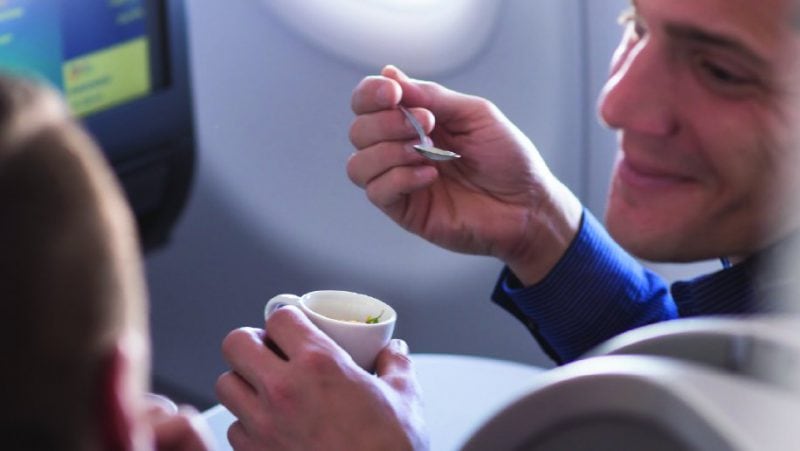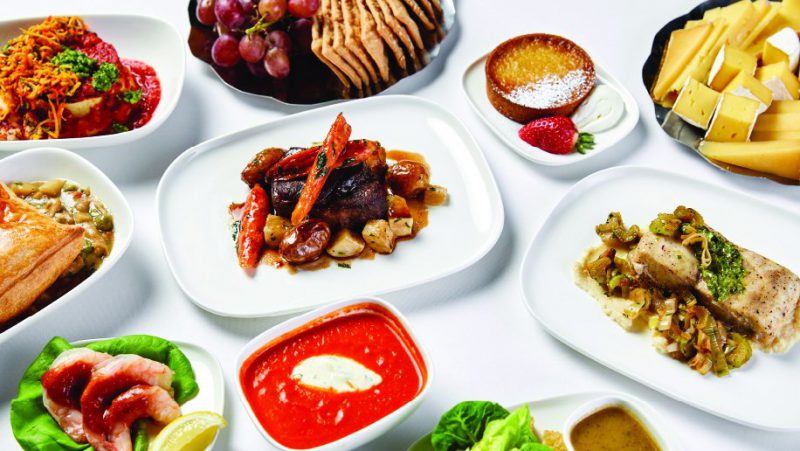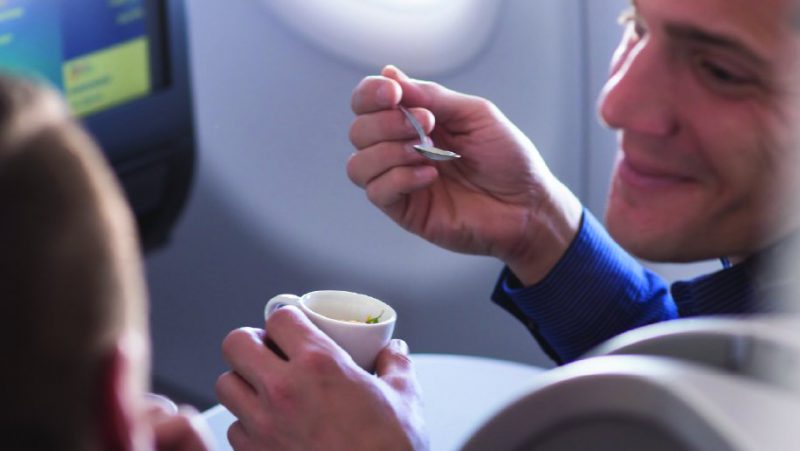Secret Sauce
Airlines competing for the passenger palate are launching culinary options to new heights
February 28, 2020


If airline food were a color, it might be the new black. The dining space on an airline is a $6 billion industry in the US alone with surprising twists and turns and a story that is never boring. There are trends to be tested, menus to be made, stand-outs to be celebrated and innovations to be discovered all centering around that 17-inch tray table setting.
It wasn’t always like this. As recently as the early aughts, airline food was what was zapped and served under foil in unrecognizable clumps of food groups. And on those flights that are generous enough to still serve food on shorter routes, those descriptors still apply. However, for longer flights with heavy route investments and competition at the higher price points, the galley remains a front to be conquered.
“‘Nine-Eleven’ changed everything about the US airlines and suddenly airlines stopped serving food onboard,” says Suzy Badaracco, a toxicologist, certified chef, and registered dietitian who consults with airlines over their food programs and publishes an authoritative newsletter on the topic called Culinary Tides. “Now they are trying to catch up and have no idea which way they are going. While one airline decides to serve pizza onboard, another will try to put food truck kiosks near the departure area in a hodgepodge of efforts,” she explains.
“However, one trend that has emerged recently is a wider choice of meal types that passengers who are actually receiving meals can select ahead of time – beyond the usual kosher, halal or dietetic options.”
Catering worldwide will be a $28 billion global industry by 2026, growing about five percent per year, according to a report from Transparency Market Research. While a few airlines do some of their catering in-house, most in-flight meals and snacks on major US airlines are supplied by catering companies.

Amuse Bouche
Some US airlines are trying to change this fact. American Airlines plans to spend $100 million on new flight kitchen facility at DFW Airport for airline catering operations. The airline recently officially partnered with the James Beard Foundation to reflect philosophies and the talents of up and coming chefs on its menus.
United Airlines got in on the food splash with serving stroopwafels (a confectionery treat made in the Netherlands from two layers of dough with caramel syrup in the middle) instead of pretzels or peanuts. But then they decided to pull back on that perk. Delta recently started greeting coach customers on international flights with trays of peach-flavored Bellinis.
The efforts are varied and creative but may not be enough to sway customer choice.
A 2019 J.D. Power International Airline Destination Survey reveals that when passengers book flights internationally, food and the overall inflight experience are far more important than price in deciding which carrier to book.
“A low fare may be the best way to attract a first-time international passenger,” said Michael Taylor, travel intelligence lead at J.D. Power, “but retaining passengers on routes to Europe and Asia is all about delighting customers with great inflight experiences. One of the most powerful ways to do that is with food and beverage offerings that are unique to the airline’s culture and that manage to deliver flavor at altitude, where it has been proven that taste buds grow less sensitive.”

Health Equation
To that end, the Food Policy Center at Hunter College co-sponsored a study focused totally on the food product on airlines and rated eleven airlines according to its “heath score” criteria. Alaska Airlines took the top spot as the airline with the ‘healthiest’ food choices in the sky with Delta right behind, as well as Air Canada and JetBlue.
Perhaps the JetBlue accolade was ironic as it mostly offers packaged snacks and sodas onboard in coach, although in unlimited quantities. Alaska was noted for its acquisition of Virgin America and its seeming willingness to take on some of that airline’s healthy approach to food. The new meals are lighter and healthier and all nutrient information for these meals is available on its app.
The study did note that the average number of calories per menu choice in coach was 373 – a 32 percent drop from earlier years.
Calories continue to count on overseas flights – a problem for passengers when there is little to do but eat, sleep and watch movies (or work).
Singapore Airlines, however, figured this in when it partnered with Canyon Ranch Spa Company in 2018. The airline took a holistic approach to lifting the passenger experience with healthy dining choices, along with guides for optimizing sleep and stretching to keep the blood flowing. Menu items available in premium and business class include such light fare as wild caught prawns, ceviche, organic chicken with zucchini pasta and organic egg omelets.
“Lobster thermidor remains one of the most popular choices in the network,” says James Boyd, vice president of public relations for Singapore Air. “And then you have these other dishes that are 100 percent health-oriented and developed by Canyon Ranch – and everything in between: Comfort food, noodles, from fun to fine. But like that second glass of Krug, you might not have it on the ground but would on a relaxing flight,” Boyd notes.
“With Canyon Ranch dietitians and sleep specialists we have been able to develop a roster of meals and programs to make sure passengers arrive feeling as good as they can. Roughly a third of the meals (on some routes) are wellness inspired.”
When it comes to culinary considerations, Singapore Airlines has not just raised the bar on what dining at 30,000 feet can be, it propelled it into the stratosphere. The focus now comes with a push to offer the freshest ingredients possible with a peerless farm-to-flight approach that is expanding quickly.
Singapore Airlines partnered with AeroFarms, the world’s largest vertical organic, hydroponic farming operation that is practically walking distance from Newark Liberty International Airport. When the world’s longest non-stop flight – EWR to SIN – takes to the skies from this gateway aboard an A350-900, multiple meals are required needing fresh ingredients. Boyd says the airline is seeking out other similar opportunities on the West Coast where the airline has flights from Los Angeles, San Francisco and Seattle.
Other carriers are testing out this system as well. Korean Airlines recently purchased a farm for this purpose on Jeju Island. Japan Airlines, Emirates, even JetBlue have been experimenting with ways to incorporate volumes of freshly harvested organic foodstuffs into flight menus.
“From a quality perspective working with very local suppliers in exploring these innovative processes is very exciting,” says Boyd. “There is so much testing that anything that doesn’t work at altitude is eliminated. Some foods, cooked at, say, 40 percent and reheated on the aircraft work very well and some things that don’t need to be heated – salads, smoked salmon – work great. Fresh items right off the farm hold up really well as they are served cold.”
Galley Gurus
Singapore’s “Book the Cook” program has been grabbing attention since it started in 1998 and today includes a star-lined International Culinary Panel of chefs who weigh in on the menus and food preparation for flights launching from their respective home bases. For Singapore the inflight dining experience in First, Business and Premium cabins is supposed to come close to a pricey dinner out.
On the board are:
Alfred Portale (US) is the internationally lauded pioneer of New American Cuisine. Chef Portale’s flagship is New York City’s Gotham Bar and Grill.
Carlo Cracco (Italy) is known as a leader in the new generation of progressive Italian cuisine. Chef Cracco’s two-Michelin-star restaurant, Ristorante Cracco in Milan, garners worldwide attention for his creative takes on Italian classics.
Georges Blanc of France regularly earns the three-star rating in the Michelin Guide for his restaurants in Vonnes on the Swiss border, some six hours drive from Paris.
Matt Moran of Australia has received prestigious awards in Australia for his creative musings with locally available foods.
Sanjeev Kapoor of India is a best-selling cookbook author, restaurateur and winner of several culinary awards and is known for fusing north and south India culinary traditions.
Suzanne Goin (US) brings her distinctly Californian concepts to international favorites developed through her Los Angeles flagships, Lucques, A.O.C and Tavern.
Yoshihiro Murata of Japan approaches Japanese cuisine from a global perspective and delivers into his dishes a distinctly French accent. His Michelin starred restaurant, Kikunoi, can be found in Kyoto and Tokyo.
Zhu Jun of China offers dishes that carry his signature Shanghainese character, with a touches of Sichuan, Huaiyang, Fujian and Guangdong influences.
The program allows passengers in the premium classes to order their meals ahead of their flights so that once on board the coveted dishes will be available to them. The pre-ordering also has the advantage of helping the airline cut down on waste – a burgeoning problem in the industry.
The airline puts out some 65,000 meals a day from its Changi Airport facility, with the daunting task of preparing 1,500 meals for a full flight in five hours. The facility is a vast complex, almost its own city, of precision operations that was stunning enough to be featured on the Netflix production, [ital] Mega Food. [end ital]
Turkish Airlines is also following suit in the galley gourmet race with its Flying Chef amenity that has the chef, toque blanche and all, riding with each flight to ensure the creamy pumpkin soup, colorful shish-kabobs and amazing mezzes are prepared to perfection. With new innovations in food preparation that include separating ingredients into similar groups, freezing items to proper points and at a certain time intervals and then cooking the foods with the appropriate heating technology, what’s celebrated on the ground can be matched with near-flawless just-rightness in the air.
Fleet to Street
Where will sky’s-the-limit culinary advances go in the next few years? One airline is experimenting with the idea of taking airline food from the heights to ground level with an air-to-avenue restaurant concept.
Low-cost Malaysia-based carrier AirAsia opened its first restaurant in a mall in Kuala Lumpur in December, offering the same food it serves on its flights as it makes plans to open 100 more outlets in the next five years. Foodies can now indulge in Pak Nasser’s Nasi Lemak and Uncle Chin’s Chicken Rice on the ground and also consider other passenger favorites, including pineapple pish noodle from Cambodia and chicken inasal with garlic rice from the Philippines, along with regionally-sourced coffees and desserts (nasi lemak quinoa wrap or onde-onde cake, anyone?).
“We have seen a significant appetite for our in-flight menu offerings beyond our flights across the region and this is our answer to that demand,” says restaurant general manager Catherine Goh.
Advice to airlines? Fasten your seatbelts and get ready to land.




